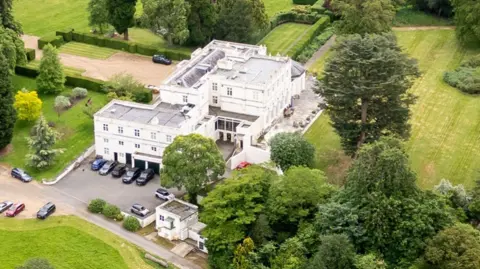The lease agreement between Prince Andrew and the Crown Estate for his Windsor home Royal Lodge.
The deal that means Prince Andrew can still afford to live in Royal Lodge
43 minutes ago
Sean CoughlanRoyal correspondentShareSave

A document has emerged, which the BBC has seen, showing the lease agreement between Prince Andrew and the Crown Estate for his Windsor home Royal Lodge.
The controversy around his connection to sex offender Jeffrey Epstein, which has seen him give up titles including the Duke of York, has thrown the spotlight on his living arrangements and how he is able to fund them despite not being a working royal.
With Prince Andrew mired in scandal, it’s a terrible look for the Royal Family to have him living among them in apparent splendour in the Grade II listed building.
His deal on the 30-room mansion means he has only ever paid a token annual rent – and even that might not be required under the terms of his lease.
That is because the arrangement with the Crown Estate landlords struck in 2003 meant that, instead of paying annual rent, Prince Andrew made large lump sum payments up-front, including for renovations.
In effect, those payments meant he was buying himself out of future rent obligations for the duration of the 75-year lease.
In information separately published by the National Audit Office, Prince Andrew had to pay for £5 million worth of repairs, £2.5 million for the option of buying out future rent and a further £1 million premium to the Crown Estate.
The rent is described as a “peppercorn”, which means a small sum such as £1, which can be paid every year on a long lease, as part of a legal arrangement between a tenant and the landlord.
It’s not about making a profit but is a symbolic payment, in this case from Prince Andrew to the Crown Estate, the independent property company that owns Royal Lodge, which boasts a gardener’s cottage, a Chapel Lodge, six-bedroom cottage and security accommodation.
There might now be questions about where Andrew got the funds in 2003 to effectively pay more than £8 million for a lease for life, an up-front payment arrangement that helps to explain how he can currently afford to live there, given he does not have to make a monthly payment.
The deal was based on a notional rent of £260,000 per year, which meant his initial payments represented about 33 years of rent up to 2036, with the years of the lease after that being effectively at no cost.
And the NAO said the refurbishments went on to cost Andrew more than £7.5m, rather than the initial £5m anticipated by the deal.






